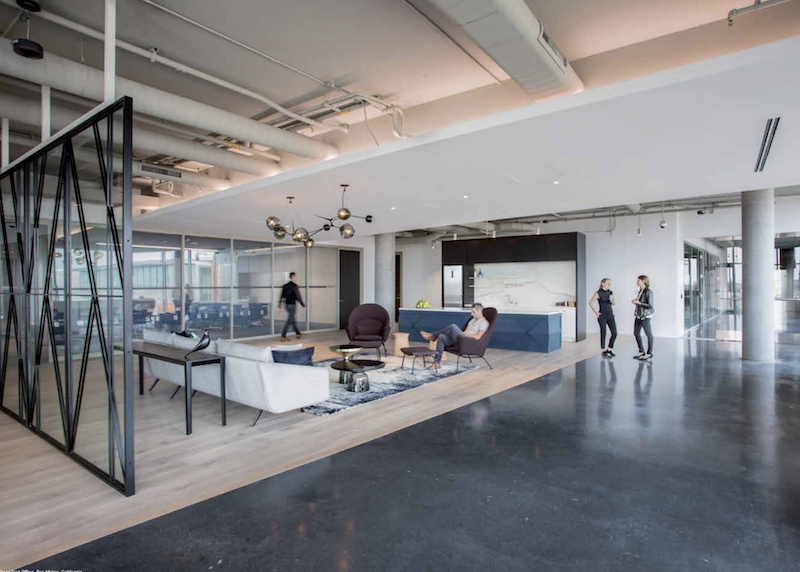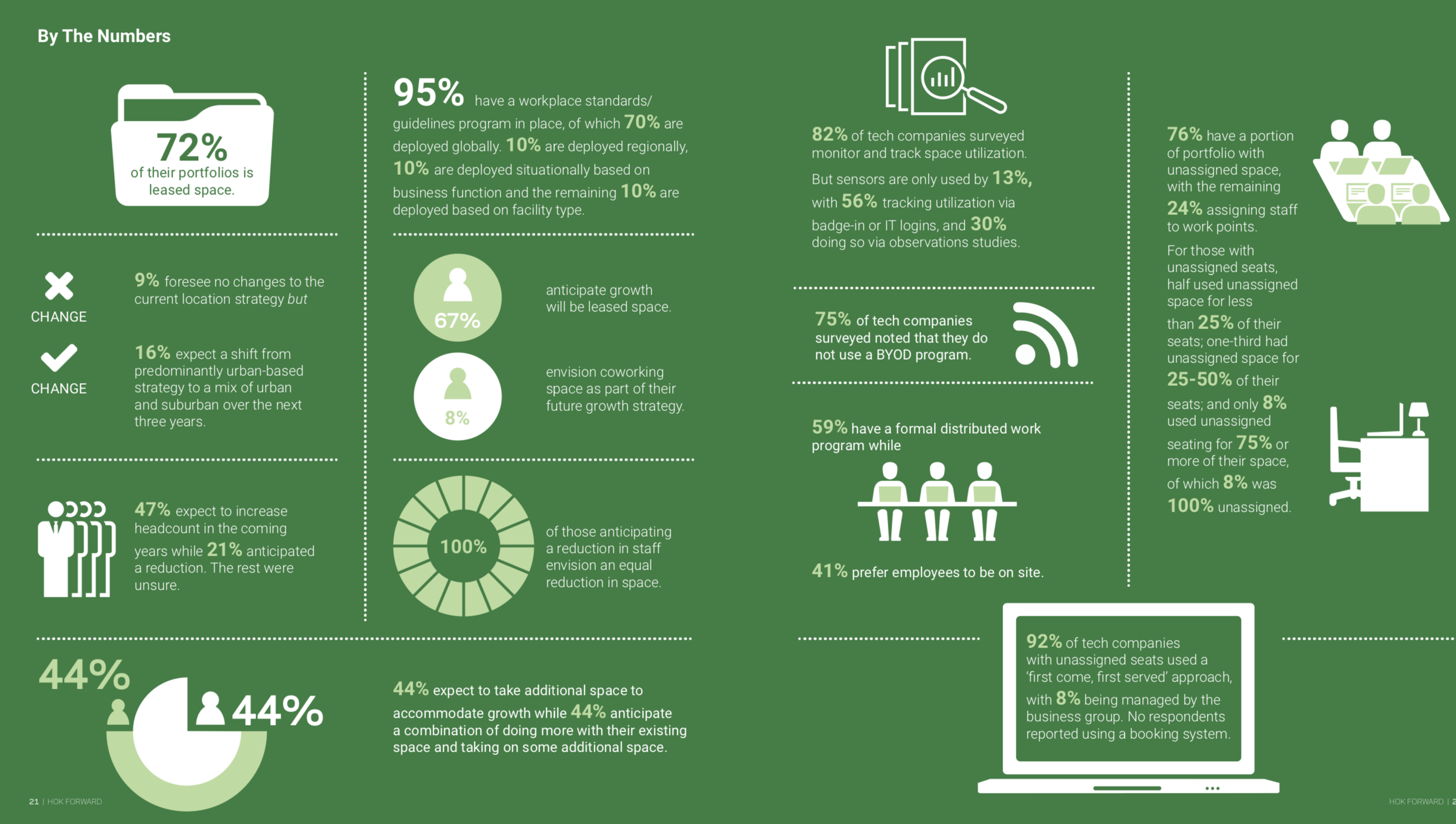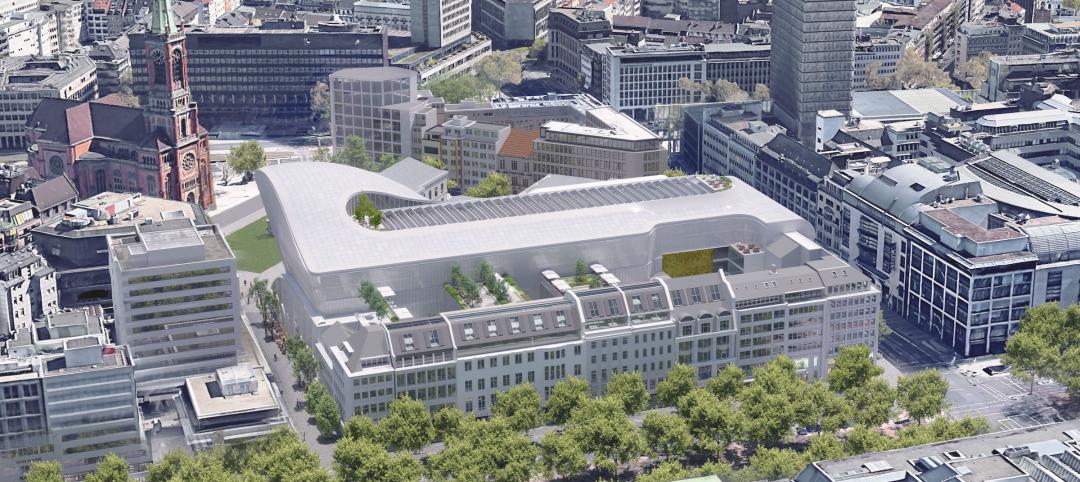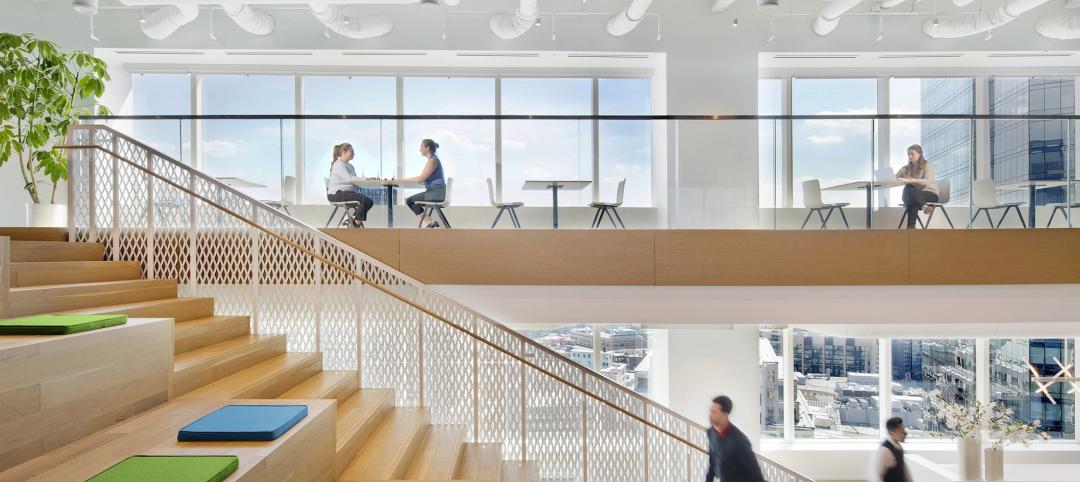How are leading tech firm responding to their workplace challenges? That’s a question that HOK, the global design firm, examines in “HOK Forward: Tech Workplace Takes Center Stage,” an 83-page report based on input from the firm’s Workplace leadership and global delivery network partners.
As part of its research to identify best practices, HOK’s team interviewed a who’s who of end-user tech companies, including Cisco Systems, Google, IBM, Microsoft, Nokia, Spotify USA, and T-Mobile.
One of the report’s observations is that tech is now all-pervasive in the workplace. “We are quickly evolving toward an era in which tech is not just a discrete sector but a foundational element of all businesses,” the report states. ”More and more companies are considering themselves ‘tech’ companies regardless of the sector they are in.”
The report notes that as tech companies expand into traditional industries, they often have a competitive advantage because they fall outside the purview of state and federal regulations. However, that regulatory climate is changing, as options for nascent technologies are defined and sometimes restricted, and bigness is no longer seen as an unassailable virtue.
The HOK report, based on input from the firm's Workplace leadership and global delivery partners, portrays a tech industry that is weighing all kinds of factors that might enhance the user experience. (Click for larger image) Image: HOK Forward report
There is also the question of whether technology is, inadvertently, accelerating the expected obsolescence of businesses. Globally, the average life expectancy of a company is less than 20 years. Up to 80% of today’s businesses may not exist in 10 years, states the report.
On top of—or, perhaps, because of—that churn, nearly half of all global employers are struggling to fill positions. Consequently, Tech employers are enticing professionals to join their organizations from other sectors. “To ensure that their people remain valuable, productive and engaged, tech employers must adopt retraining and redeployment strategies,” the report states.
In this high growth sector, HOK’s survey portrays an industry whose companies tend to lease in urban environments. These companies continue to increase their headcounts, but envision accommodating more people within their existing footprint before deciding to expand. More than two-fifths (43%) of companies polled prefer to have employees on-site, and are designing their environments to encourage synergy, ideation, and speed to market.
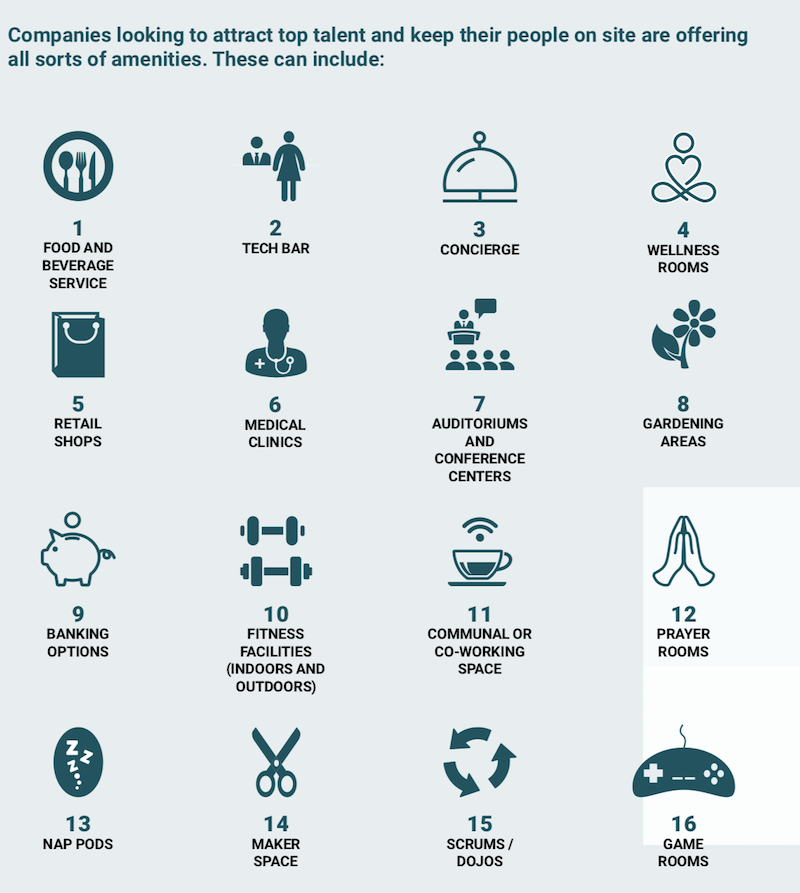
The right mix of amenities is critical to creating a workplace that foments innovation and productivity. Image: HOK Forward report
The cost of real estate—the cost per sf for tech office space ranges from $80 to $300, and averages around $190—and time spent at the office continue to be the most important factors influencing workspace allocation. These companies’ top priorities include enhancing the employee experience and creating flexible spaces.
While tech companies insist that they value sustainable design, 87% said they wouldn’t seek formal LEED certification for their workplaces, and—here’s a stunner—92% did not intend to seek formal WELL certification for workplace wellness.
That being said, amenities are evolving: Companies looking to attract and retain top talent now offer everything from nap pods and wellness rooms to medical clinics and maker spaces.
“Smart“ workspaces, tracked by networks of sensors, are increasing, too, as designers and clients continue to learn how to leverage data in order to optimize and right-size space that reflects the company’s culture, work style, mobility profiles, and business goals.
The report provides a wealth of case studies that illustrate many of its findings. It also offers readers a list of “priority actions” that revolve around flexibility, employment empowerment, training, and “leveraging the contingent workforce.”
The report predicts that the next generation of high-performance tech workplaces will function as engagement centers and dynamic hubs where people gather, connect and innovate.
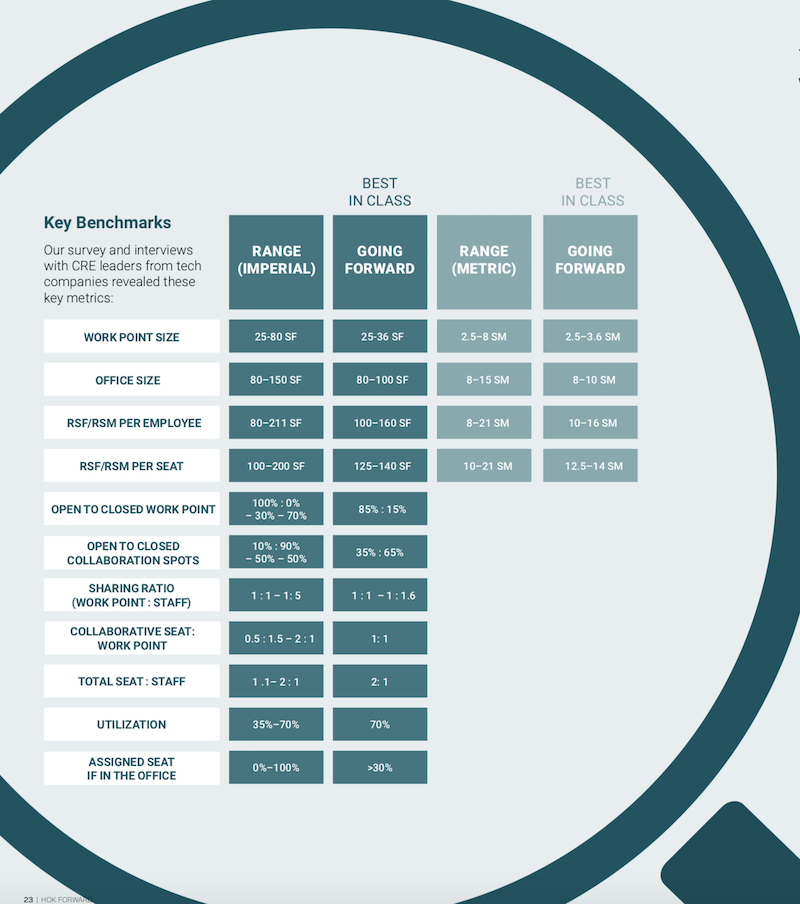
Some of the key office metrics, gleaned from interviews with leading tech companies. Image: HOK Forward report
“By focusing on human-centric metrics and thinking outside the box, we can create resilient tech workplaces that adapt to whatever the future may bring. We need to design this next- generation workspace with courage if we want to keep pace and truly transform the work experience.”
The report recommends 10 “focus areas” for growth-minded tech companies. They must create a “curated” workplace that emphasize innovation, amenities, and occupant wellbeing, which includes giving workers greater control over their work environments.
Companies should also be looking beyond sustainability—and toward net-zero energy and water, biophilia, and human health. They should also be using sensors more to gather data in order to track employee patterns and preferences.
HOK’s report advocates that companies rethink the suburban campus of the past and move toward a “new urban model” that emphasizes “blended, mixed-use environments that are revitalizing urban zones and catering to neo-urbanites.
The conundrum of this recommendation, however, is that building offices in urban centers is challenging and expensive. In addition, while the population migration to cities is “unprecedented,” a big portion of the middle class—“the bedrock of a city’s workforce,” acknowledges the report—continues to relocate to the suburbs, “posing additional challenges for urban locations that aspire to serve as thriving work centers.”
Related Stories
Retail Centers | Feb 24, 2023
Santiago Calatrava unveils plans for a luxury retail and office complex in Düsseldorf, Germany
Renowned architect and engineer Santiago Calatrava, along with the CENTRUM Group, has unveiled plans for Calatrava Boulevard, a luxury retail and office complex in Düsseldorf, Germany. Running parallel to Königsallee and connecting with the Steinstrasse station, Calatrava Boulevard will incorporate and connect to the boulevard’s existing buildings.
Reconstruction & Renovation | Feb 16, 2023
Insights from over 300 potential office-to-residential conversions
Research from Gensler finds that, surprisingly, the features that result in an unpleasant office often make for a superlative multifamily product.
High-rise Construction | Feb 15, 2023
Bjarke Ingels' 'leaning towers' concept wins Qianhai Prisma Towers design competition
A pair of sloped high-rises—a 300-meter residential tower and a 250-meter office tower—highlight the Qianhai Prisma Towers development in Qianhai, Shenzhen, China. BIG recently won the design competition for the project.
Office Buildings | Feb 12, 2023
Smyrna Ready Mix’s new office HQ mimics the patterns in the company’s onsite stone quarry
Designed by EOA Architects to showcase various concrete processes and applications, Smyrna Ready Mix's new office headquarters features vertical layering that mimics the patterns in the company’s stone quarry, located on the opposite end of the campus site. The building’s glass and concrete bands are meant to mirror the quarry’s natural contours and striations.
Office Buildings | Feb 9, 2023
Post-Covid Manhattan office market rebound gaining momentum
Office workers in Manhattan continue to return to their workplaces in sufficient numbers for many of their employers to maintain or expand their footprint in the city, according to a survey of more than 140 major Manhattan office employers conducted in January by The Partnership for New York City.
Giants 400 | Feb 9, 2023
New Giants 400 download: Get the complete at-a-glance 2022 Giants 400 rankings in Excel
See how your architecture, engineering, or construction firm stacks up against the nation's AEC Giants. For more than 45 years, the editors of Building Design+Construction have surveyed the largest AEC firms in the U.S./Canada to create the annual Giants 400 report. This year, a record 519 firms participated in the Giants 400 report. The final report includes 137 rankings across 25 building sectors and specialty categories.
Codes and Standards | Feb 8, 2023
GSA releases draft of federal low embodied carbon material standards
The General Services Administration recently released a document that outlines standards for low embodied carbon materials and products to be used on federal construction projects.
Giants 400 | Feb 6, 2023
2022 Reconstruction Sector Giants: Top architecture, engineering, and construction firms in the U.S. building reconstruction and renovation sector
Gensler, Stantec, IPS, Alfa Tech, STO Building Group, and Turner Construction top BD+C's rankings of the nation's largest reconstruction sector architecture, engineering, and construction firms, as reported in the 2022 Giants 400 Report.
Giants 400 | Feb 3, 2023
Top Workplace/Interior Fitout Architecture, Engineering, and Construction Firms for 2022
Gensler, Interior Architects, AECOM, STO Building Group, and CBRE top the ranking of the nation's largest workplace/interior fitout architecture, engineering, and construction firms, as reported in Building Design+Construction's 2022 Giants 400 Report.
Multifamily Housing | Jan 23, 2023
Long Beach, Calif., office tower converted to market rate multifamily housing
A project to convert an underperforming mid-century office tower in Long Beach, Calif., created badly needed market rate housing with a significantly lowered carbon footprint. The adaptive reuse project, composed of 203,177 sf including parking, created 106 apartment units out of a Class B office building that had been vacant for about 10 years.


